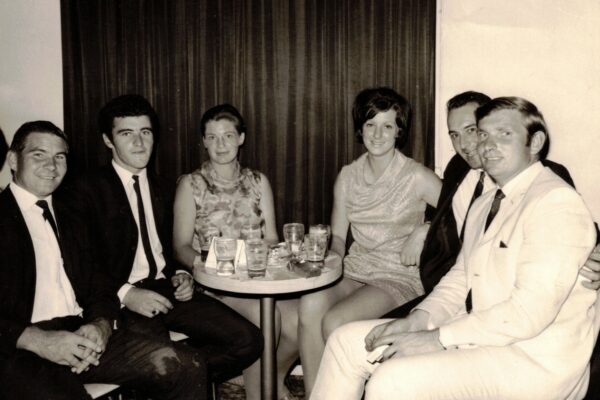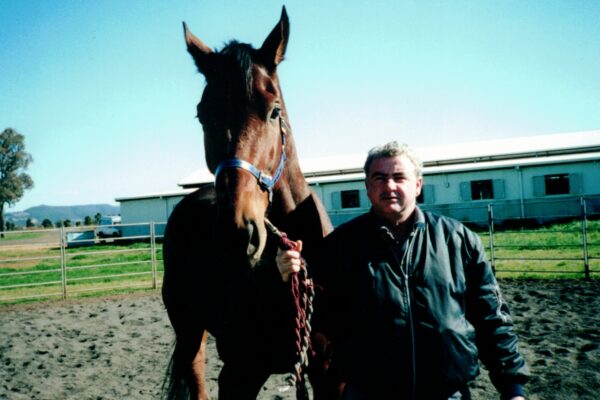Hunter Valley Hero
Have you heard of Wyatt Earp and the gunfight at the OK Corral? Almost certainly you have. Have you ever heard of Edward Denny Day and the gunfight at Doughboy Hollow? Almost certainly you have not? I contend the latter is by far the most noble and heroic. We have not enjoyed the dubious benefit of the hyperactive steroidal mythology of the American West richly embellished by Hollywood and TV.
I had the consummate honour of launching a book at the Historical Society in Scone. It is called From Convicts to Comedies – A History of Scone’s Court Houses. Its author Veronica Antcliff is the current Clerk of Petty Sessions at Scone Court House. By remarkable coincidence Mathew Miller built the original Court House in Scone before his own home Belmore House aka Geraldton where we now live. It was meant to be. I am indebted to Veronica for introducing me to the remarkable career of Edward Denny Day. I was totally ignorant before.
Edward Denny Day (1801-1876) was the son of Reverend John Day a clergyman of the Church of England in County Kerry, Ireland, and his wife Charlotte née Denny. In 1820 he joined the 46th Regiment as an ensign and in 1833 became a lieutenant in the 62nd Regiment. After serving in India he resigned from the Army in 1834 citing ill health. He then went to Sydney where he obtained employment as clerk to the Executive Council. He served in the office of the colonial secretary in 1835. In 1836 he married Margaret fourth daughter of the postmaster-general James Raymond. There were six sons and five daughters from the marriage. Day was appointed police magistrate at the Vale of Clwydd (Hartley and Lithgow) in January 1836, Maitland in January 1837 and Muswellbrook in October 1837. In Muswellbrook his circuit included Merton and Invermein. His duties included visiting Invermein on a fortnightly basis. His jurisdiction extended beyond the settled districts of the Liverpool Plains and the country west of the Great Dividing Range up into what is now Queensland. There were at least two episodes where Edward Denny Day established his outstanding credentials as a hero of law enforcement in the emerging infant Colony.
William Hobbs was overseer of Thomas Dangar’s three properties on the Big River. He discovered that a group of aborigines had been murdered at Myall Creek (near Bingara). Consequently he wrote to the Police Magistrate at Invermein. The following letter is held at the State Records and may be viewed on their website. It has also been displayed at the National Museum as part of an exhibition of nationally significant documents.
Peels River July 9th 1838
Sir
I beg to acquaint you that about a month since I had occasion to leave Mr Dangar’s Station on the Big River for few days. On my return I saw near the Hut the remains of about thirty Blacks principally women and children. I recognized them as part of a Tribe that had been at the station for some time and who had since they first came conducted themselves in a quiet and proper manner. On making enquiry I was informed that party of White men had come to the station who after securing them had taken them a short distance from my Hut and destroyed nearly the whole of them. I should have given information earlier but circumstances prevented my sooner coming down the country.
I am’
Sir
Your obt Servant
W Hobbs
E D Day Esq
Police Magistrate
Invermein
In June 1838 under instructions from Governor Sir George Gipps Day led a party of Mounted Police to arrest white men said to have killed at least twenty-eight Aboriginals at or near Henry Dangar‘s station at Myall Creek on the Liverpool Plains. He was away for 53 days before he reported back to the Governor in person. Day carried out a thorough investigation. Eleven suspects were arrested and walked back in chains under guard to Muswellbrook; a distance of almost 300km. They were committed to trial in Sydney. Hobbs became one of the main Crown witnesses in the subsequent murder trials. In the first trial eleven men were charged with murdering an Aboriginal man and found not guilty. Seven of the men were immediately re-arrested and charged with the murder of an Aboriginal child. In the second trial these men were found guilty and sentenced to death by hanging. It was the first time a group of white men were arrested, charged and hanged for the murder of Aboriginal people.
As Police Magistrate again at Maitland he was also Commissioner Court of Requests from 1841 and significantly of insolvent estates from 1842. This was somewhat ironic. Day had liquidity trouble later himself. He played a major part in public life in Maitland becoming a foundation member of the Australian Immigration Association and elected chairman of the Maitland branch.
Edward Denny Day’s most famous exploit involved chasing and capturing bushrangers. On Sunday 20th December 1840 he happened to be visiting Muswellbrook on private business. He learned of a gang of bushrangers led by Edward Davis (The Jewboy) who had terrorized settlers in the Scone district for several months raiding cattle stations and breaking into homesteads. In one raid the clerk in a store at Scone John Graham was murdered. Captain Day organized a party of mounted men fortifying his posse of sturdy locals with ticket-of-leave men. Does it take one to know one or at least think like they do? He pursued the bushrangers without any assistance from his successor Police Magistrate in Scone. The Jewboy Gang raided and pillaged on their rampant foray north replenishing their reserves with food, ammunition and fresh stolen horses on the way. Eventually Day and his gallant troupe came upon the bushrangers’ camp. They arrived about three hours after the outlaw gang. Following very heavy rain they had to reload their damp firearms. The lawmen engaged with and captured five of the outlaws after a short skirmish at Doughboy Hollow near Ardglen just north of Pages Creek (Murrurundi); a sixth was arrested the next day. At least eighteen shots were fired by the renegades including two aimed directly at Denny Day. It may be their aim was somewhat sullied by bibulous behaviour: they had raided a pub at Pages Creek. The bushrangers were desperate men and knew that capture meant certain death.
The detained desperados were eventually escorted back to face justice under guard and secure in chains. All were tried and found guilty: they were hanged on 16 March 1841. Grateful residents of the Scone district presented Day with a service of plate for his efforts. He would not have been short of crockery because he received several similar gifts on subsequent occasions. It may be that he would have preferred the presents in hard currency as he was somewhat profligate in trade and cavalier in commerce.
Edward Denny Day’s subsequent professional career was less eventful. On 16 February 1844 he laid the foundation stone of a new gaol at East Maitland. This was the same gaol where in 1897 Charles Hines a son-in-law of Mathew Miller was executed for the rape and carnal knowledge of his step daughters and daughters between the ages of 10 to 14 at Gundy. Is this too much information? Never delve too deeply into family history. In January 1846 as representative of Governor Gipps Denny Day laid another stone for a new hospital at Maitland. Day’s business ventures proved less successful and his estate was sequestrated in 1848. Liquidity became a problem until rescued by a government pension. Next year he was appointed to Sydney and from 1 January 1851 was provincial inspector of police for the northern district. He was obliged to resign this position following a drunken incident at the Mayor’s fancy dress ball. His career had indeed passed the pinnacle. In June 1853 he was appointed stipendiary magistrate at Port Macquarie; after five years he was transferred to Maitland where he served until 1869. He then again retired at Maitland where he died on 6 May 1876. He was buried in the Anglican cemetery at East Maitland.
Edward Denny Day had indeed demonstrated enormous courage and liberal fortitude. The almost two month sojourn in the saddle to Myall Creek in the high New England country would have severely tested the mettle of anyone. Confronting the desperate heavily armed Jewboy Gang with an amateur posse demanded exceptional pluck. Both episodes are firmly entrenched into Australian folklore. The hero has remained all but anonymous. There are numerable press references and plaques commemorating his resolution and devotion to duty but nothing approaching the tributes for Sheriff Earp. It may be that gunfight at the OK Corral resonates much more than the equivalent at Doughboy Hollow? Police Magistrate Edward Denny Day does not have quite the same ring to it as the Earp brothers and Doc Halliday. Perhaps we can invent better titles. Is this nominative determinism at work or simply representative of superior American chutzpah?










